Conceptual Modeling
"Well, remember that what an ideology is, is a conceptual framework with the way people deal with reality. Everyone has one. You have to -- to exist, you need an ideology. The question is whether it is accurate or not. And what I'm saying to you is, yes, I found a flaw."
- Alan Greenspan
"This model will be a simplification and an idealization, and consequently a falsification."
- Alan Turing
The Conceptual Modeling Industry
Did you ever wonder about the secret structure of the universe or about the underlying reality and purpose of the world ? If the answer yes, you probably have use a conceptual model of some sort. In fact, there are several gigantic multi-billion dollar industries devoted to the promotion and sale of conceptual models - those industries are Education, Religion, Science and Politics. Did I say multi-billion dollar ? I must have meant to say multi-trillion dollar, at least for the Political industry. In fact, almost everything you can't eat, wear, drive or live in is a conceptual model. It's a very big market.
Joking aside, conceptual models are one of the cornerstones of human condition, arguably the thing that sets us above most of the other animals. Yet, most of us are barely conscious of their existence. This presentation will not fill that void - but it may raise the level of awareness a bit.
The material presented is to some extent academic in nature. However, I have tried to streamline things as much as possible, at times sacrificing rigour and completeness for simplicity and clarity.
For a good example of abductive reasoning see the atricle Alan Greenspan vs. Ayn Rand and Freedom - asserting that the connection between Alan Greenspan and Ayn Rand is being used to blacken her[sic] name ... and where are the snows of yesteryear ?
Also see the Interwiki on Concept Modeling.
Definition of a Model
Definition of Model
At the core of conceptual modeling is the idea of a model. The Wikipedia defines a model as "an abstract (or actual) representation of an object or system from a particular viewpoint". [ Note: this definition has changed, but I still like the old version ]
There are three parts to the definition above - an object or system, a representation and a viewpoint. It is critical to understand the role of each element of a model.
An Object
An "object or system" is essentially an unknown and perhaps unknowable thing; an object as something in the world to be modeled has potentially an unlimited amount of information associated with it. For instance, a chair as an actual physical object in the world possesses innumerable structural characteristics, such as materials and their strengths, as well as myriad facts about the styles of the chair or its history, for instance who sat upon it ( say, it was your great grandfathers chair and consequently is irreplaceable ). There might be many thousands of possible facts associated with a single chair.
A Representation
Of all the many thousands of characteristics associated with a given object, there may be only a few facts or facets that are of interest to us, a few dozen facts as opposed to many thousands. Whenever we use a chair, our mental representation of the object discards at least 99.999% of all information about chairs and focuses exclusively on the 0.001 % of the characters that effect us, most commonly whether it will hold me up without breaking or tipping over.
A Viewpoint
The representation of an object is further simplified by picking a particular viewpoint according to the need of the moment. For instance, if someone is considering standing on a chair to reach something on a shelf rather than just sitting on it, the fact that the seat is made of woven cane would be the most important aspect of the chair for from that particular viewpoint - it would be more likely to break than a metal chair. Even if it were a fairly substantial chair, the fact that it was your grandfather's chair might make it unusable as a step ladder - far better to make a trip to the basement and get a ladder rather than risk breaking it.
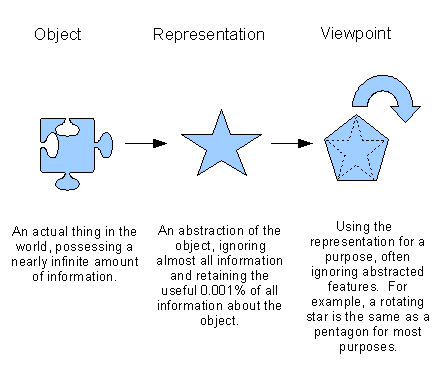
We perform the mental gymnastics of mapping from object to representation to viewpoint effortlessly and naturally. Many people are unaware that they are doing it. However, when one is forced by circumstance ( or inclination ) to try to get a computer to perform commonsense tasks of this sort, it can be a very difficult to accomplish.
Qualitative or Commonsense Reasoning
During the late 1980s, a group of academics investigating models of physical systems developed a set of guiding principles to help them perform simulations. The purpose was to perform an amazing and unprecedented feat of computation - predicting that water spilled on the top of a table would eventually drip on the floor.
It may not sound like an impressive achievement but it was huge step forward for conceptual modeling. Before their conception of qualitative physics, a simulation would require the solution of complex simultaneous equations, a computational task not far from calculating the course of individual water molecules.
The central figures were Kenneth Forbus and Johan de Kleer, who edited the classic text of the field, "Qualitative Reasoning about Physical Systems" ( occasionally availible on amazon.com ). It sparked a small and very quiet revolution in the computer simulation of complex physical systems. Interest also spread into the area of human cognitive processes, something that could be called commonsense reasoning.
Function, Structure and Behavior
The cornerstone of idea was a very simple. There were three components to a physical simulation - function, structure and behavior. The modeler starts with one of the three components, say a structure, and then derives the function of that structure ( what can be accomplished with it ) for a given set of behaviors ( actions ).
A typical example might start with the structural description of a hammer and a inventory of possible behaviors ( actions ), such as - 1 ) swing it from the handle, 2 ) throw it, 3 ) lay it on top of something, 4 ) attach it to something, etc. From these behaviors, one can derive the functions of 1 ) driving a nail, 2 ) driving away pesky critters from the garbage bin, 3) keeping papers form blowing away, 4 ) sinking something that floats, etc.
There are six possible mappings between the three components.
| Mapping From Input: | For a Given: | To Output: |
| Structure | Function | Behavior |
| Structure | Behavior | Function |
| Behavior | Structure | Function |
| Behavior | Function | Structure |
| Function | Structure | Behavior |
| Function | Behavior | Structure |
The conceptual framework is quite simple to use. For instance, if someone needed to drive a nail but did not have a hammer, one might look for things structurally similar to a hammer ( solid, heavy ) that could be used with the same action as a hammer ( pounding on the nail ) to achieve a given function ( to drive the nail into a board ). This would be the equivalent of the fifth type of mapping on the list, that is from function ( drive nail ) to structure ( something like a hammer ) for a given behavior ( pounding ).
Note that the order is important. It is not likely that someone would whack on the nail with a heavy glass vase - the search is for something structurally similar to a hammer. The question is, what can I use to pound the nail into the board ? The required 'what' is something like a hammer, so the variable output is structure, not behavior or function, which are both fixed.
It is a very simple conceptual framework, but has surprising power to describe the workings of physical systems at a high level of abstraction. The concept was so powerful that that it was picked up by software architects to describe non-physical systems, such as the workings of object-oriented software.
Design Patterns
The first mention of design patterns in relation to software was made in 1987 by Kent Beck and Ward Cunningham ( who also invented CRC Cards ). The idea of design patterns then kicked around for a few years, but became popular in 1994, with the classic text "Design Patterns: Elements of Reusable Object-Oriented Software", edited by Erich Gamma, Richard Helm, et al.
The Wikpedia defines a design pattern as "a general repeatable solution to a commonly occurring problem in software design. A design pattern is not a finished design that can be transformed directly into code. It is a description or template for how to solve a problem that can be used in many different situations".
Since 1994, the number of design patterns has proliferated but for the most part, they have remain true to Gamma's original classification identifing three types of design patterns - structural, behavioral and creational patterns. The creational patterns are roughly equivalent to the functional component of the function-structure-behavior model. An example of a structural pattern is a "Composite", which composes individual objects into a collection, often represented as a hierarchical "tree" structure.
An example of a behavior is the "Mediator" pattern, which determines how two objects interact independently of the object themselves, decoupling explicit references to one another, somewhat like a business rule.
Zachman Framework
Six Categories of Questions
Journalism majors know the drill by heart. The First Law of Journalistic Excellence, the 5 "Ws" of Reporting ( and an "H" throw in just to make life difficult for journalism students ). The Law states: every journalistic oeuvre must answer these eternal questions - who, what, when, where, why and how. That's a fine principle for overworked journalism students, but what about the rest of us, for example they who toil tirelessly in the murky mines of Infotechnology.
Enter the Zachman Framework.
A Generic Conceptual Framework
A Zachman Framework provides a generic analytic template that can be used to model ( in theory ) any entity that exists or can be thought to exist, more specifically the interactions between the entities. It is in the form of a table or spreadsheet with the top row containing the six questions and the left column containing the subjects of attention or under discussion. In practice, the model is usually centered on business process.
Note that in the "Real" Zachman Framework, the subject on the left side are 5 "stakeholders" in the business enterprise - the Planner, Owner, Designer, Builder and Subcontractor. While these five categories have some relevance to a Semantic Web, at the level of conceptual modeling their usefulness is limited. In fact, any 'well-formed' collection of interacting subjects will work in a Zachman model. Below is a simplistic example of a customer ordering a product, with approval from the credit department of course.
| Why | Who | What | Where | When | How | |
| Customer | Order product | Customer | Product X | Kansas City | Today | Phone |
| Order | Fulfill Order | Order Dept | Product X, Quantity, Price |
Newark Office | Tomorrow | Standard Shipping |
| Credit | Approve Credit | Credit Dept | Credit Approval | HQ | Today | CCA System |
Mapping Subjects to Categories
Usually the empty slots in the framework fill in easily and fairly naturally, giving a basic sense of who the players are and what they are doing. The order of the questions in the row can be significant. The model above is focused on 'why' and 'who'. From the perspective of the order fulfillment process, the questions 'what', 'where' and 'how' might be the most significant. Each category of question can become a pivot point for a greater level of detail in the model.
A Deeper Understanding of the Six Categories
Below are more detailed descriptions of the six categories. The definitions are fairly flexible, indeed, they need to be.
| Why | The function, purpose goal or objective of some activity, what is going to be gained, with a measure of success if possible. |
| Who | A person, actor, organization or group. |
| What | A thing, situation, action, an aggregate of things, an idea or ontology. |
| Where | A place, a physical or namable location, potentially a situation in the sense of a state in a series of expected events. |
| When | A point in time, a span, duration, or interval, an event or sequence of events, a temporal context of some sort. |
| How | Steps, a manner, procedure, a capability to to change, transform or control something. |
Sometimes, there are subtleties in the interaction between the subjects and questions that require a deeper understanding of the subject in order to assign them to a specific slot.
Fuzziness of the Subject
For example, there might be a business policy saying that all orders for a highly profitable product that happen to be out of stock in one location will be shipped out the next nearest location, even at a higher shipping cost for the company. In others words, locations of shipping point and distances between them are suddenly an important factor - it requires a fairly complex locator function to map from "what gets shipped from where" to "where it gets shipped to". A deeper understanding of 'where' is required.
Fuzziness of the Category
There may be significant features of a situation that demand a stretching of the categories themselves. For instance, the category of 'where' can include a sense of 'where are we in moving toward our objective", with a clear sense of moving nearer or farther away from it as if it were a definite location. The category 'when' may refer to a window of opportunity rather than definable instant or duration of time. In this case, there is a sense is of moving in time toward the window, but once it is past, that time is no longer accessible, it's too late. In other words, a window of opportunity behaves more like a 'when' than a 'what' or 'where'.
Often the fuzziness is based on the type of task being performed. For instance, detailed planning tasks have strong elements of 'how' and 'when', mixed with in 'what', in the sense of the plan itself as a concrete structure of tasks. There is also a sense of 'what' tasks need to be performed, although these tasks are probably more properly modeled as 'hows'.
Leveling the Model
More confusion can arise by mixing different levels of interaction among the subjects, such as mixing the high level concepts of' why' or 'what to do' with lower level concepts, 'when, 'where' and 'how' to do it. In the case of a framework for planning, the model would show the interactions between the plan and other plans or objective in the organization. It would not work to mix interactions between the plan and its constituent parts within the same subject framework. The framework needs to be 'leveled' the same as any other model - things of basically the same type need to be shown at roughly the same level of the model.
The E-Z Framework
The Zachman Framework is both powerful and flexible. There are several extensions and variations of the Zachman Framework available in the marketplace. In fact, it can be used as a form of 'meta-model' to map the features of two models.
Mapping the FSB Criteria to the E-Z Framework
Mapping the three model qualitative reasoning concepts, Function, Structure and Behavior ( "FSB" ), against the six categories of the Zachman Framework produces a sort of 'main sequence' of shared characteristics, running from the top left to the bottom right.
| Mostly Function | Mostly Structure | Mostly Behavior | ||||
| Why | Who | What | Where | When | How | |
| Function | purpose, goal, objective | initiator, prime actor | ||||
| Structure | group or organization | thing, aggregate, ontology | place, location, situation | date/ time, duration, interval | ||
| Behavior | temporal context, sequence | change, transform, control | ||||
This diagonal mapping implies that subjects will tend to group themselves according to the FSB criteria. A paragraph above said that "things of basically the same type need to be shown at roughly the same level" of the model - the 'types' correspond to the FSB criteria.
For instance, in the example of a customer ordering a product, the subjects on the right are mostly functional subjects rather than structural or behavioral. If the subject were production planning, the subjects would be mainly structural descriptions, such as product configuration, raw components and sub-assemblies, inventory locations, highly structured production schedules reflecting aggregated lead-times for processing steps, etc. At a lower level would be behavioral descriptions of specific processing steps, such as stamping or lathing, mixing chemicals and maintaining a certain pressure and temperature for some duration of time.
Mapping between Subjects, Relations and Modeling Levels
Each E-Z Framework model will show a type of subject and interactions between them. Each will also have aspects of all six categories of questions within them - even a lower level manufacturing step has a 'why' associated with it. But a processing step is primarily a behavioral 'how' and 'when' and not a functional 'why', it would be modeled properly on the same level as other behavior entities, rather than mixing up it with functional and structural entities.
Logical Inference
Republished Jan 16 2009, from a an old tutorial article. Will be expanded and revised in coming months. Also see InterWiki on Logical Reasoning.
Note that while much of the following may seen dry and 'ho-hum', it is actually very controversial in its use of fuzzy, everyday notions about logic rather than exact and exacting mathematical formulations. What's the matter, haven't they heard of faith-based mathematics ? ;-)
The Ubiquity of Logical Inference
All people utilize some form of conceptual model to make inferences about in their everyday lives - buying things, crossing the street, solving a problems at work, preparing dinner. Logical inferences set conceptual frameworks in motion. Assuming that the conceptual model is accurate, inferences allow us to make useful decisions and sensible plans of action in the real world.
Yet how many people have actually examined the the way they go about using logical inference ? The answer is very few.
The term 'logical inference' may conjure up an image of crusty academics furiously splitting hairs over the obvious, perhaps with some justification. But sometimes what seems obvious is not all that obvious. It's a result of the difference between logic and language. Logic is precise and everyday language is imprecise. People like the fuzziness of language - it can bestow deep significance upon common things ( like toothpaste or soap ) or allow us to give answers which sound meaningful but are utterly devoid of meaning, as the situation requires. There is a warm and fuzzy feeling about everyday language because it works for us in ways that logic does not.
The Fuzziness of Everyday Language
Language is riddled with fuzzy logic that helps to describe the fuzziness of human situations and experiences. However, communicating with machines requires a logical type of language, one with sufficient precision to accomplish useful tasks in a predictable way. To speak the language of rules, one must master the rigors of basic logic. This requirement is frequently underplayed by companies selling business rule tools and methodologies. They tend to paint a picture of a brave new world where business people rather than programmers encode business logic for transaction processing systems. While the business rules approach shifts the focus from arcane computer languages to a more natural way of expressing business logic, that does not free business people from having to understand how logic works, quite the contrary.
Logical Boot Camp
The next few sections are a sort of 'logical boot camp', perhaps reviving memories of a sleepy afternoon in a high school or college math course many years ago. After reviewing the basics of logic, the following sections discuss the three mode of logical nference.
Basic Logic
The Basics of Logic
Much of the complexity of a collection of rules arises from interactions between logical expressions within the rules ( also called logical 'terms' ). Unless rule base designers work assiduously to simplify rule expressions, they will be rapidly overwhelmed by the complexity of the rule base.
Venn Diagrams
One of the most powerful tools available to rule base designers to help simplify complex rule expressions is Venn Diagrams. The idea is simple - every example of something in the world can be put inside of a circle. It helps rule base designers to visualize the consequences of rules. For instance, there is the most classically Greek or all logical expressions is:
Socrates is a man
All men are mortal
Therefore Socrates is mortal
The same expression in Venn Diagram form is:
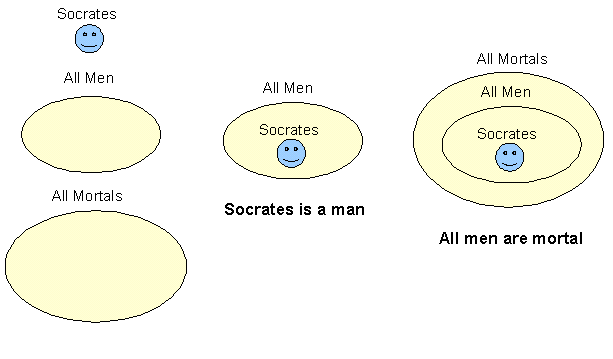
The deduction appears to be almost trivial when the terms are expressed in a diagram. It's like big fish swallowing little fish ( that just swallowed Socrates ) The deduction can also be expressed in a more general form ( the "ABC" form ).
IF A is a B
AND All B is C
THEN A is C
This expression is valid for anything that can be placed into slots A, B and C.
Visualizing Rules with Logical Expressions - AND, OR, XOR
Frequently, expressions are in a different form than a simple construction of terms "A AND B", where both must be true for the expression to be true. There may be cases where either "A OR B" can be true for an expression to be true.
For example, a store might have a policy about their days of business with a rule that days of operation are "weekdays and Saturdays", in other words they are closed on Sundays. Note that using everyday language, the rule would be expressed as "weekdays AND Saturdays", which means that the store will never open because there will never be day which is both a weekday and a Saturday. A precise expression in a more constrained rule format would be something like "IF day = aWeekday OR day=aSaturday THEN StoreOpen = true".
In everyday language, the word "AND" usually means add the two together, as in the case of "weekdays and Saturdays". The logical definition of the word AND is saying "when the two are true together", which means that when either one is false, the two are rejected. In other words, a logical AND works more like subtraction than addition. The logical OR effectively add the two groups together.
The diagram below show the adding and subtracting behavior of logical OR and AND, with the help a new category "Things Named Socrates", including people, pets, computer applications, anything denoted by the word 'Socrates'.
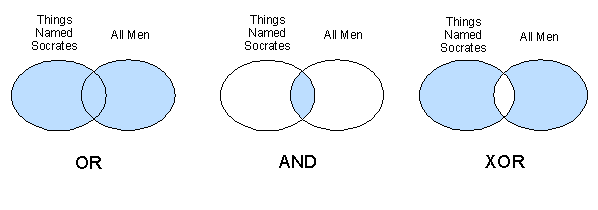
The diagram for the OR expression shows all things in the world named Socrates ( people, pets, whatever ) plus all men in the world, and all women too ( ancient Greek philosophers must have intended to include women in their propositions as well ). This diagram demonstrates an almost visual sense of addition, as if a logical OR were merging visual layers in a drawing.
The AND expression shows the only those things in the world which are both men and named Socrates ( not pets ). In the caseo fthe AND construction, there is a sense of subtracting out anything that is not common between the two visual layers.
The third diagram shows an example of a common logical expression, the XOR ( eXclusive OR ) expression. It is saying "things which are either named Socrates or are men, but not both named Socrates and are men. In fact, it is the exact equivalent of saying "A OR B AND NOT ( A AND B ). In the sense of a visual analogy, iIf you take the OR expression on the left and subtract the AND expression in the middle, you can derive the XOR on the right.
Using Negation in Expressions - NOT
The use of NOT in logical expressions can complicate set of a rules very quickly. To express the behavior of the NOT operation In Venn Diagram form requires creating of new element, that is a rectangle representing a universe of all possible things.
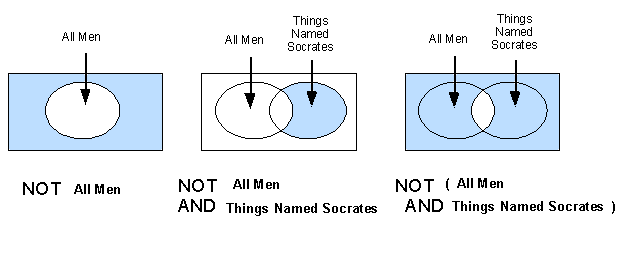
Note that evaluating the expression in the middle yields 'all things named Socrates that are not men", including pets and computer applications, but not people.
The expression of the right shows a new feature of logical expression that goes under various names - bracketing, closure, etc. It says "evaluate the expression between the parenthesis first and then evaluate the outside expression". As you can see, adding the parenthesis to the expression "All Men AND Things Named Socrates" alters the meaning considerably.
In fact, the use of parenthesis to control evaluation order is discouraged in rule base design. The alternatives will be discussed in the section "Rule Base Design".
The Three Modes of Inference
The three modes of logical inference are deduction, induction and abduction. At this point it may be may be helpful to look at formal definitions of the terms.
Deduction
Wikipedia defines deductive reasoning as:
... reasoning in which the conclusion is necessitated by, or reached from, previously known facts. If the premises are true, the conclusion must be true. This is distinguished from abductive and inductive reasoning, where the premises may predict a high probability of the conclusion, but do not ensure that the conclusion is true.
Induction
The Wikipedia defines inductive reasoning as:
... the process of reasoning in which the premises of an argument are believed to support the conclusion but do not ensure it. It is used to ascribe properties or relations to types based on tokens (i.e., on one or a small number of observations or experiences); or to formulate laws based on limited observations of recurring phenomenal patterns.
Abduction
The Wikipedia defines abductive reasoning as:
... the process of reasoning to the best explanations. In other words, it is the reasoning process that starts from a set of facts and derives their most likely explanations. The term abduction is sometimes used to mean just the generation of hypotheses to explain observations or conclusions, but the former definition is more common both in philosophy and computing.
Developing a Working Set of Tools
The assertions of these two modes of forms of inference may or may not be 'true' according to the circumstances - certainly, they can never be 'true' with the absolute metaphysical certainty characteristic of logical deduction. The meaning of 'inferring from consequences' is discussed in the following sections.
Note that the definitions presented below are overly broad and might even be considered eccentric from the exacting perspective of classical and modern mathematical logic. The intention is not to probe the deep inner workings of mathematical logic but to develop a set of workable set of tools to solve common problems. The definitions given below might legitimately be said to represent a 'hammer and tongs' approach to using logical inference in rule based systems ( when it works at all ).
Deduction and Implication
Most of classical Greek logic is based on the principle of the excluded middle. The basic structure is an observation, a rule and a conclusion. The most famous example of a logical expression is the deduction:
| Observation:
Rule: Conclusion: |
Socrates is a man
All men are mortal Therefore Socrates is mortal |
A graphic representation of the rule with a Venn diagram.
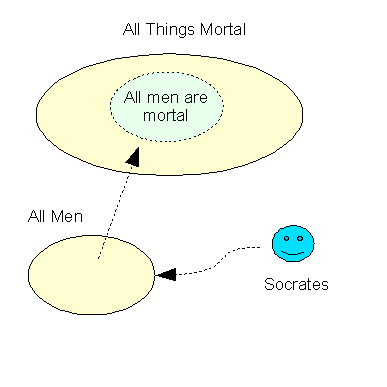
The excluded middle in the case of deduction is the term "men", inferring that Socrates must necessarily share in the mortality of all men. Another way to express the idea is:
Socrates -> Man,
All Men -> Mortal,
Therefore assert that Socrates -> Mortal
In a more universal form, the principle of the excluded middle can be expressed as:
IF A -> B,
ALL B -> C
THEN A -> C
This holds true for anything true statement that can be inserted into slots A, B and C. Assuming that the two premises are true and that one sticks to the meaning of ALL B -> C, then by the laws of deductive logic, the conclusion is guaranteed to be true, every time.
There are some extra details about what can actually be inferred when the relationships ( -> ) between A, B and C are of certain types, such as inheritance of characteristics or ownership of something else. Another complication is when "some" rather than "all" of B has a relationship to C and one can legitimately infer that NOT ALL B -> C. Obviously, it can become very complex, even with a small number of assertions. It's a involved subject, to be covered with more details in later sections.
Logical Chaining
Exact deductive inference of this kind forms the backbone of most inference engines in rule based systems. If the observations are actually 'true' and and the rules are stated in an exact manner, then the inference engine work exactly as intended. Of course, there are the pragmatic problems of ensuring the truthfulness of the observations and the precision of the rules. However, in principle, deductive rule engines should work as advertised.
Deduction the Only Valid Form of Reasoning
Of the three forms of inference in rule based systems, deductive logic is the only universally 'valid' form of logic. Deductive logic moves from the specific to general, inferring 'true' assertions about the nature of things in the world from 'true' ences of these assertions.
The other two forms are inductive and abductive inference: they are capable of producing inexact and even unexpected conclusions. Induction moves backward from the specific to the general, inferring from consequences to implied causes. Abduction moves kind of laterally, that is from general to specific as in the case of deductive inference, but by the process of association of characteristics rather than by identifying membership in some category. This is why abduction is often called false deduction.
It is the other two forms of inference that can give 'exact' logic a bad name.
Induction and Learning
Expressed in the inductive form, the same set of assertions about Socrates would be:
| Observation:
Observation: Rule: |
Socrates is a man
Socrates is mortal Therefore All men are mortal |
The same rule could be epxressed graphically.

The exclude middle is Socrates, linking Men and quality of being mortal. But clearly there is a problem here. There is an implicit assumption that Socrates represents all men or more explicitly, "Man is Socrates". We know that is not true but, nonetheless, this sort of inference seems to occur quite often in everyday language as over-generalizations. In fact, we could equally associate "men and "mortals" in the other direction and conclude that "All mortals are men", based on the sole example of Socrates.
What does this mean ? One way to interpret it is by reading the conclusion as "Based on what we know about Socrates, there is no reason to reject the assertions that "all men are mortal" or that "all mortals are men".
Disproving the notion that "all mortals are men" is an easy task - the first mortal bird or squirrel encountered along the highway would disprove it beyond doubt. However, the only way to prove finally and forever the mortality of all men is to examine every human on earth ( including Pythagoras ) and determine the presence or absence of mortality in their set of personal characteristics. Clearly. it is an impossible task since there would always be the possibility of someone being born who just might disprove the ancient assertion.
Beyond Any Doubt ?
In this sense, induction can never prove anything beyond all doubt, only very high degrees of likelihood. The mathematical laws of probability can set an upper limit on the likelihood of error, ( assuming that the experimental method was correct, which is not always the case ). In the case of the assertion that "all men are mortal", it is as certain as any truth we know. Even as rough 'guesstimate', one can say that the chance of error is no more than one in many billions ( the 'true' probability of error is much smaller, of course ).
The Scientific Method
Induction by experimentation is the basis of the scientific method and knowledge discovery. Most rigorous statistical and numerical-intensive techniques fall into the inductive mode. There are many effective models and methods for inductive learning, such neural networks and various types of associative networks. The results of these models may be difficult to interpret, but they are easy to use these days.
An important feature of inductive inference is capability to measure precisely the degree of error in associating data from a large population with the generalized rule. This is in stark contrast to the abductive mode of inference.
Abduction: Inference with an Attitude
The final form of inference is abduction often called ( somewhat falsely ) by the name of " false deduction". However, abductive inference it is not always false.
Abduction is the "guilt by association" mode of inference. The question of deduction is not "what logical conclusions can I infer" but rather "does it have a certain something ?". The abductive form of the classical expression:
| Observation: | Socrates is mortal |
| Rule: | All men are mortal |
| Conclusion: | Therefore Socrates is a man |
A diagram of this inference would look like:
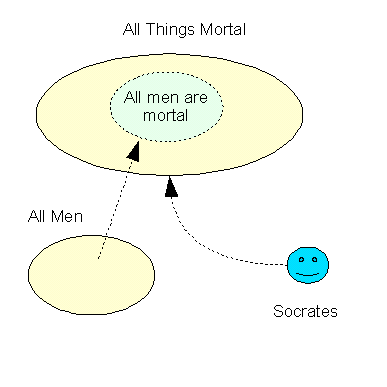
It is tempting to say that the exclude middle is the quality of being mortal, except it is not really the middle but the ends of the assertions that are being excluded. Returning to the ABC form of inference, the 'excluded ends' principle of inference could be expressed as:
IF A -> C,
ALL B -> C
THEN A -> B USUALLY FALSE !
The reading would be that "if two things share a quality, it means that the are same thing", which may be true occasionally, but is far more likely to be false most of the time. In the case above, the association between Socrates and men happens to be correct, since after all is said, Socrates is a man.
But why not substitute another true assertion about "All somethings" and see how it works.
| Observation: | Socrates is mortal |
| Rule: | All cats are mortal |
| Conclusion: | Therefore Socrates is a cat |
Graphically it could be represneted as:
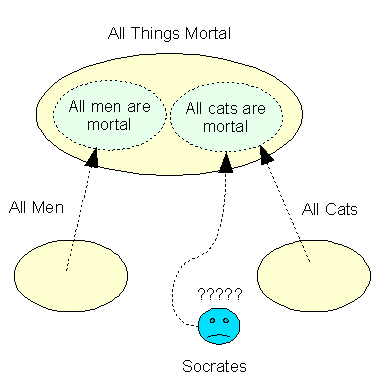
The 'excluded ends' are the quality of being mortal, arriving at the erroneous conclusion that "Socrates is a cat". If the rule were stated as 'only cats are mortal', then the inference that "Socrates is a cat" would be inescapable, if still untrue.
Real World Abduction and Classification
Identifying things by a single characteristic is not the way abductive inference works in the real world. Someone performing a classification task would use a full set of 'relevant' characteristics in order to identify Socrates as either a man or a cat. Does he have fur, how many legs does he walk on, etc. There would be a rough sense of fitness of the match between the characteristics of the thing and the categories being tested, sometimes expressed as a "distance function" between the thing being tested and the ideal. There might also be a scoring mechanism to put greater weight on certain matches. For instance, a match to 'feathers' would probably have a higher scoring weight than 'skin' - Socrates could only be a a bird.
Classification
Abduction is the Great Classifier of reasoning. The phrase "if it looks like a duck and it quacks like a duck then ..." is a classically abductive statement. As attractive as it sounds, this is not a valid mode of reasoning - it is the result of association of characteristics between two subjects, maybe with some practical screening mechanism to improve the chances of success. It is neither a true deduction nor a valid statistical induction about the relationships between the subjects themselves.
Abduction as an Early Warning System
If false deductions are invalid, why do we keep doing it ? We do it because it works well of us, as it has for many millions of years. The old adage, "where there's smoke there must be fire" is a perfect example of a cautionary abductive inference and may provide a hint as to why the abductive mode of inference holds such power over our cognitive processes. It's an early warning system and often a very effective one.
A Procedure for Reasoning by Analogy
Solving Difficult Problems
Abductive reasoning is similar to reasoning by analogy - the process of equating a well-understood thing with a poorly-understood thing in order to solve a difficult problem that could not be solved directly. In effect, analogy substitutes important characteristics of the known thing for those of the unknown, based on the similarity of their shared characteristics.
In fact, examples of analogy abound in economics and physics, such as using an analogy of a circulatory system as a stand in for economy or using the abstraction of a perfect gas to model stellar dynamics or the Big Bang. Most modeling and simulation techniques are to some extent practical applications of reasoning by analogy, and they often work very well in predicting the behavior of things that can not be measured directly.
Case Based Reasoning
Another important and very practical application of abduction is "Case Based Reasoning". CBR has a rough and ready concept of degree of matching or 'distance' between examples of some thing. The 'Case' in CBR take a legal turn when searching a large database of rulings and precedents whose characteristics match those of a current legal case. CBR has practical application in product design and engineering as well.
Peirce's Theory of Inquiry: Multi-Modal Inference
A great American philosopher of the late 19th century, Charles Peirce, discovered a neat system to explain how the three mode of inference work together to drive the process of scientific inquiry. The Wikipedia has a good description of Peirce's Theory of Inquiry.
In the roughest terms, abduction is what we use to generate a likely hypothesis or an initial diagnosis in response to a phenomenon of interest or a problem of concern, while deduction is used to clarify, to derive, and to explicate the relevant consequences of the selected hypothesis, and induction is used to test the sum of the predictions against the sum of the data.
These three processes typically operate in a cyclic fashion, systematically operating to reduce the uncertainties and the difficulties that initiated the inquiry in question ... the purpose of abduction is to generate guesses of a kind that deduction can explicate and that induction can evaluate.
The basic flow of the inquiry and discover process is illustrated in the diagram.
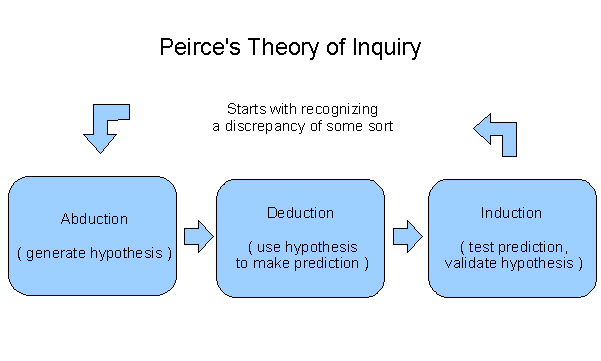
{ Example of above}
So ... Is Socrates a Cat or Not ?
Using the previous example where we concluded that "Socrates is a cat", one could further deduce that since "Socrates is a cat" and "All cats have four legs" ( most cats anyway ), Socrates must also have four legs. This is a hypothesis that can be confirmed or rejected based on inductive inference. If we observe that Socrates only has two legs, then the hypothesis deduced from "Socrates is a cat" can be rejected.
Observation:
Rule:
Conclusion:
Socrates has two legs
All cats have four legs
Therefore it is NOT true that Socrates is a cat
( The hypothesis is rejected )
Note that the logical expression is in the form "NOT Socrates is a cat", rather than saying "Socrates is not a cat". This is one of the irreducible complexities of logic which will become critical in the design of an engine to automate or 'externalize' the process of inference. For now, note that from a logical perspective, saying "NOT Socrates is a cat" is distinct from saying "Socrates is not a cat", that is, "Socrates is a cat" is false and "Socrates is not a cat" is true.
The steps outlined above are a rough approximation of a rigorous environment, but it looks as if a pragmatically formulated set of inference tools can be made simple and intuitive enough for everyday people to use solving complex reasoning problems.